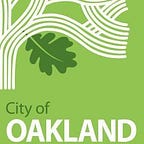Community Cabins Documentation Project
In late 2017, the City of Oakland piloted a novel approach initiated by Mayor Libby Schaaf to help people living in street encampments gain security and support: the City found a site location at 6th and Castro streets, funded the operational costs of a site manager, security and supportive social services, then asked the business community to buy and outfit 20 “cabins” to shelter up to 40 people at a time.
Sincethen, four Community Cabin sites have opened and two more are planned to open this summer. This work is part of the City’s Encampment Management Team (EMT), a cross-departmental, partner inter-agency team that works to alleviate homelessness with a temporary housing intervention plus wrap-around services for encampment residents.
The Civic Design Lab came together with the EMT to document the process and efforts to set up a Community Cabin site. In this initial phase, the CDL focused on internal City departments and a few key partners who were crucial in the process. A potential Phase II will focus on speaking with service providers and exploring the “negative exits” of Community Cabin residents.
CDL spoke to 16 people across six City departments and three City partners to understand each department’s specific role in establishing a Community Cabin site. Beginning with Joe DeVries, Assistant to the City Administrator, and Talia Rubin, a program analyst in the Community Housing Services Division of Oakland’s Human Services Department, the CDL was able to get an overview of the five phases required to create a Cabin site. The phases include: Site Selection, Internal Planning + Alignment, Design + Site Set-up, Outreach, Decommissioning Encampment + Move-In.
After speaking to Joe and Talia, we had a better idea of which departments we would first speak with to ensure that subsequent conversations built on each other. This maximized our conversations to prevent duplication and we received new information every time we spoke with another department. Some of the departments we spoke to were the Public Works department, the Fire department, and the Police department. Each conversation lasted an hour.
During our interviews, we asked each department to:
1. Describe how their department or work relates to the Community Cabins intervention to make sure we understood their scope.
2. Delineate the steps they took to set up a cabin from their department’s perspective.
3. Share their department best practices and/or recommendations to streamline the Community Cabin process.
Each department’s scope of work was mapped out during the session as they were sharing in helping to capture their steps in the cabin process. We quickly found that reflection and time to process was something that City workers rarely, if ever, get to do, and such reflection is very helpful for effective improvements and modifications to their work.
The CDL team immediately downloaded after every department conversation. We talked about what stuck out, referred back to the tape recordings if something was unclear and then synthesized the material on a Google document separated by the phases and steps performed by each department.
Throughout this work, we made sure to consider the best way to present this information to City staff because we know:
1. Process mapping is user-friendly for designers and product managers, but not necessarily City staff;
2. We need to support easier sharing of information and resources across City departments, and large design files may not be conducive to government computers, programs, etc.
3. Maps can become difficult to print and packing a lot of information on a map is not often quickly digestible for front-line employees. We even have to think about color printing as “premium” here at the City.
In the end, we decided to develop a PowerPoint deck because it is easy to share, print and use in presentations to the community or at conferences. And we realized that the Community Cabin concept lends itself well to the form of a story, rather than a map with lots of context needed.
Insights gleaned from this project could potentially set up a Phase II that would focus on service providers that support Cabin residents 1-on-1 with wrap-around services, such as finding permanent housing, jobs, counseling services for mental health and addiction recovery services. And for Cabin residents that have “Negative Exits,” exits due to a variety of reasons, this Phase would explore why that’s the case and identify recommendations for improvement and implementation.
Ultimately, for us at the CDL, this project was a great entry point and learning process for how to work on and design collaborative projects within the City, we hope to continue to build on these learnings in the future. Stay tuned.
